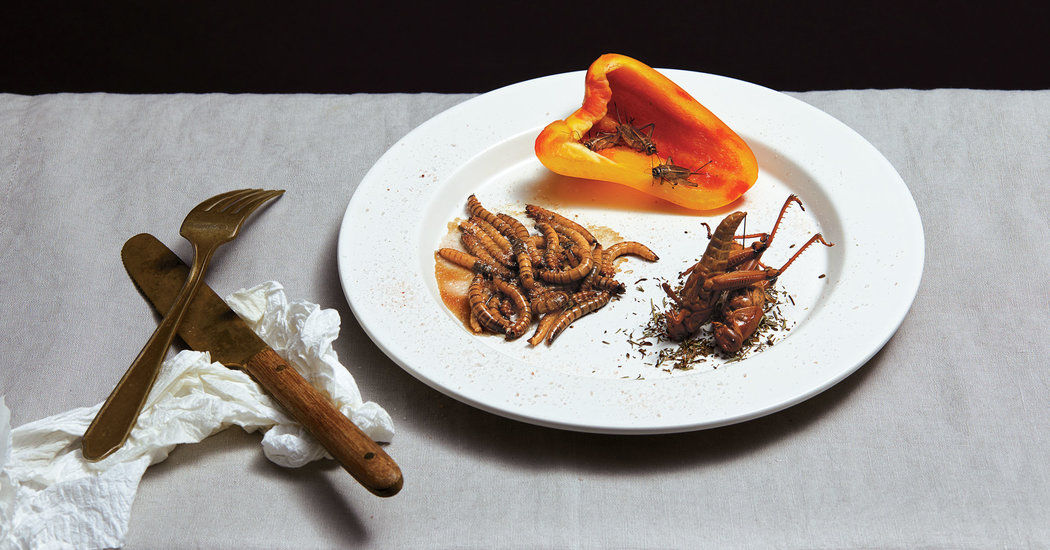
From a scientific standpoint, our rejection of bugs as food is illogical. Insects share many characteristics with crustaceans, which are coveted and esteemed; both are members of the phylum Arthropoda. David Foster Wallace, in his 2004 essay “Consider the Lobster,” noted that “lobsters are basically giant sea-insects,” with a footnote citing Maine slang for lobsters: bugs. Like insects today, lobsters were once dismissed as bottom feeders too abundant to be treasured. In colonial times, indentured servants and prison inmates were purportedly fed them almost daily, until ordinances were passed to prevent such cruelty. Only with the arrival of the cross-country railroad in the 19th century, when noncoastal dwellers had a chance to taste canned lobster, did it become an exotic, desirable dish.
Can bugs undergo a similar makeover? Some 2,100 insect species worldwide have been identified as edible, from leafhoppers and water boatmen to stink bugs and agave worms; the most popular globally are beetles, followed by caterpillars. Their nutritional benefits, while varied across species, are substantial: high in energy yield, rich in essential amino acids and comparable and sometimes superior, per ounce, to beef, chicken and pork in amounts of protein, omega-3 fats, iron, magnesium, calcium and zinc. Bugs also don’t require much nurturing by parents or space to develop, and they generate far fewer greenhouse gases than conventional livestock: one-tenth the methane and one-three-hundredth of nitrous oxide. Almost all of an insect can be consumed, as opposed to less than half of a cow (nose-to-tail eating notwithstanding). And they reproduce and grow from larvae to adult with startling swiftness — a horror story if we think of them as enemies, but a blessing if we recognize that they could keep us alive when the world’s population hits 9.7 billion in 2050 and other sources of protein run out.
Still, the idea of introducing insects into the Western diet would have once seemed improbable. Now an odd confluence of forces is at work: On one side, there are food evangelists — like Palmiro Ocampo of the recently shuttered 1087 Bistro in Lima, known to drizzle strawberries with weevil-grub fat — who view eating insects as an ancient practice that reconnects us to nature and terroir; on the other, we have technology companies that harvest “micro livestock” as a solution to world hunger and environmental degradation. Over the next few years, the Texas-based Aspire Food Group plans to build several automated cricket production facilities, where robotic modules can tend to billions of bugs annually, monitoring intake of food (organic) and water (triple-filtered), until the insects are dry-roasted whole for snacks or milled into powder.
While robots may eventually take over the cultivation of bugs, a crop like palm weevil larvae doesn’t require significant overhead or sophisticated equipment, making it ideal for small-scale family enterprise and offering a path out of subsistence poverty. Aspire has also trained hundreds of local farmers in Ghana to rear palm weevil larvae as a way of earning stable, yearlong incomes. In the past two decades, villagers in impoverished northeastern Thailand have started housing crickets in concrete pens in their backyards. As demand for the insects has risen, so have profits: One farmer reportedly went from selling 10 kilograms to more than two tons a day. Now around 20,000 such farms have been established, collectively earning more than $3 million a year.
ENDING HUNGER AND POVERTY, protecting the environment: These are sound arguments, even if they smack a little of “eat your vegetables.” But it seems archaic to be presented with cricket flour and mealworm powder — insects as abstractions — in an era when chefs have been minding the seasons and favoring the honest ugliness of gnarled vegetables over the Plasticine perfection of factory farms. We’ve shown a willingness to embrace suspect foods in the name of reducing waste, taking delight in animal parts once discarded, like pig’s feet, sweetbreads and other organs. As insects enter our larders, shouldn’t we accept them as they are?
A movement toward global food tourism may provide the push. In part, that shift is a legacy of the late writer and TV host Anthony Bourdain, who was always game to try something new, however disconcerting, because he respected the fact that in another culture, it was beloved. Now, at the fine-dining restaurant Quintonil in Mexico City, diners pay hundreds of dollars for a tasting menu that might feature grasshopper adobo and escamoles (ant eggs), which the former New York Times food critic Ruth Reichl equated in texture to marshmallows. Humbler preparations are also gaining popularity: Baseball fans at Safeco Field in Seattle happily toss back crunchy chapulines (grasshoppers); more than 18,000 orders were sold in the first two weeks of the 2017 season. The insects come from Oaxaca, Mexico, where they are a familiar snack, and cooked in the traditional style: After being boiled, dehydrated and shucked of legs and antennae, they’re mobbed by chiles and kissed with lime juice.
It can be difficult to adopt the wisdom of other cultures. But imagine the rewards of biting into a witchetty grub from the Australian bush, which Aborigines traditionally dug from the roots of acacia trees, and which the Japanese chef Shoichi Uchiyama compares to fatty tuna, at once meaty and melty. In the Nordic Food Lab’s 2017 cookbook “On Eating Insects,” Josh Evans, a Canadian researcher, describes ants foraged from a Danish forest as lemony, “with a hint of burnt sugar — like lemon rinds seared on the grill,” and a wood cockroach, when roasted, as redolent of “coffee and chocolate, malt and black mustard.”




